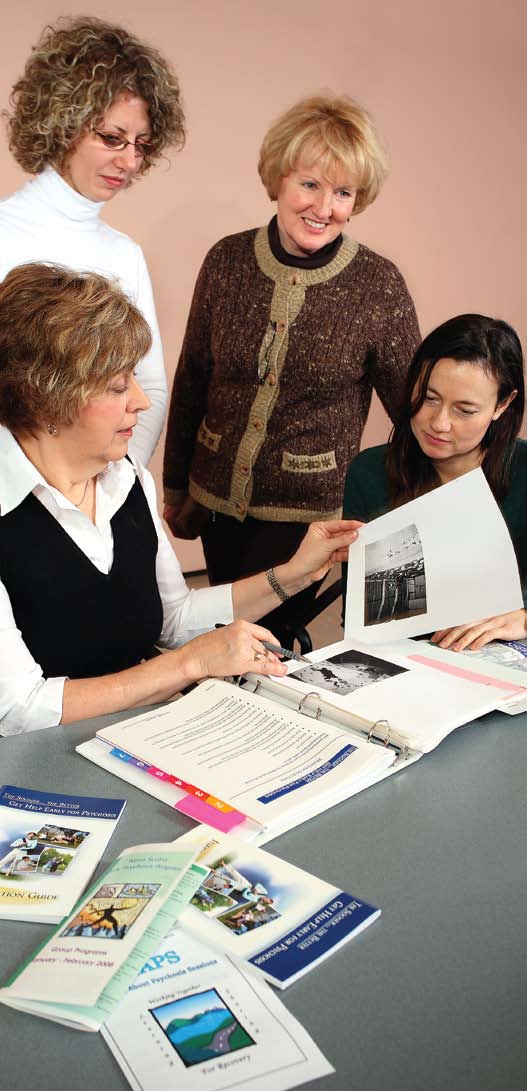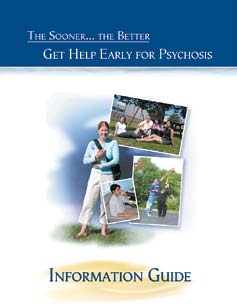Ssns.ca

Anna was visiting a friend in another city when strange things
began to happen. She saw things that looked real, but later
didn't seem real at all. She was so troubled by what she described as not
feeling like herself that she woke her friend; together, they called Anna's
parents. "She started to cry," says Anna's dad. "She was talking about things, but
we didn't know where they were coming from."
The early psychosis
A softspoken, pretty young woman, Anna returned home the next day.
After picking her up at the airport, her parents noticed that Anna was doing
programs in Atlantic
things like stopping in front of posters and tracing all the letters. In the days
Canada offer to treat
that followed, Anna became afraid of talking on the phone. "I live on the
phone," she says. "It was kinda weird." While watching television, she thought
people at the very first the actors were talking about her. Something was happening to Anna that was
separating her from the world she once knew.
signs of problems
The family's doctor saw Anna immediately. His early diagnosis was a first
episode of psychosis, signs of which include withdrawal from usual activities,
a persistent decline in ability to handle everyday activities, anxiety, irritability,
Photography by Perry Jackson
unusual or bizarre behaviour, attention problems. Although this sounds dire,
if given a chance, the brain can often heal itself. The prognosis is promising if
symptoms are treated early, a philosophy that programs in the Atlantic region
are taking to heart.
Health In At
lantic Canada •
ic Canada
• Spring 200

Nova Scotia Early Psychosis Program team members, from left to right,
Who and when?
front row: Diana Bennett, Diane Piccott, Alisa Stevens, Dr. Zenovia
Psychosis strikes three in every 100
Ursuliak, Jill Torraville. Back row: Dr. Heather Milliken, Margie Crown, Kim Good, Dr. Michael Teehan.
people, in every corner of the world, in every walk of life. Although the usual age range is 16 to 30, it can occur as early as 14 years of age.
What else might it
mean?
A first episode of psychosis can be a
see people within the week. Nobody sits on a
result of substance use, a side effect
waiting list.
of medication, or a symptom of a
Instead, the intake person sets up an
medical condition, including bipolar
assessment appointment with a psychiatrist
disorder, post-partum depression
and nurse. Other members of the care team
and dementia. The only way to
-- psychologists, occupational therapists, social
know what a first episode heralds is
workers, an education coordinator – are involved
to watch what happens, and treat
as the need arises. The team gathers as much
information as possible and starts to work on a treatment plan in conjunction with the client, and, in some case, with the family and friends.
Clients are offered medication, support,
education, and cognitive-behaviour therapy. Since psychosis is a sign of a distressed brain, treatment generally begins there, with anti-psychotic medication. The research evidence suggests that the earlier people start anti-psychotics, the better their chances. Still, clients are bleak about medication. Because of their severe side effects, older antipsychotics, such as chlorpromazine, have not been used much for the past
Cannabis conundrum
Some of the people who call upon the health care
system with symptoms of psychosis have recently used
cannabis; a few are heavy cannabis users. Although this
has led people to assert that cannabis causes psychosis,
there is no evidence of that.
There is a connection, though. A UK team recently
conducted a meta-analysis (an analysis of many studies) of cannabis research and concluded that use increases the risk of psychosis by approximately 40%. The greater the use, the greater the risk: upwards of 200%. These and other results suggest that, in some people, cannabinoid receptors aren't working properly, and that
That wasn't always the case. The prevailing
Some regions have even built the approach
that problem is part of a larger problem. However, that
view for many, many years was that no one
into health policy. Nova Scotia, for instance,
remains a question.
recovered from psychosis, and if they did, they
enacted a Standard of Care for Early Psychosis
What isn't a question is genetics. Since a great many
never had it in the first place. In the 1970s
in 2004, laying out the importance of treating
people use cannabis, and only a few develop psychosis,
and '80s, attitudes started to shift. More effort
as soon as possible. Newfoundland and New
researchers in the UK, US, Ireland, and New Zealand
and funding were going into research that
Brunswick have taken the same approach, if not
combined forces to look at genetic vulnerability. They
explored the outcomes of earlier treatment,
the policy route.
found that people with a specific mutation of the gene
the mechanisms of psychosis, risk factors,
What that means is that in those three
catechol-O methyltransferase were most likely to have
causes. The best guess about cause is that it's an provinces, anyone with concerns about a
psychotic symptoms and to develop schizophrenia if they
interaction between genetic vulnerability and
first episode of psychosis can seek treatment
used cannabis. People without the specific structure were
environment, which might mean viral exposure
without a referral, and get help quickly.
at no greater risk.
during pregnancy, exposure to substances
In Halifax, the Nova Scotia Early Psychosis
Since there is – as yet – no genetic test designed for
such as amphetamines, stress and so on. No
Program (NSEPP) sees people immediately.
at-home use, the best advice health care professionals
matter the cause, researchers have found that
The Fredericton Mental Health Centre Early
can give people is to abstain, until 21, at least. That's
early intervention improves the changes of full
Prevention Program sees people within 48
when the brain finishes developing, and may not be as
recovery from psychosis, a finding that clinicians hours. The St. John's Psychosis Intervention Early
vulnerable to environmental assaults. -JM
are incorporating into their treatment approach. Recovery program, at Waterford Hospital, will
Spring 2008 • LIVING Healthy In Atlantic Canada



The NSEPP's educational booklet.
PEI manages early intervention through family doctors and hospital emergency room.
decade. The side-effect profile of the newer anti-psychotics – clozapine, olanzapine, quetiapine, and risperidone – is not as brutal, although there are still risks such as hyperglycemia (high blood sugar) and diabetes. "There is still no utopic medication," says Dr. Zenovia Ursuliak, a staff psychiatrist with NSEPP.
Despite the kinder side-effect profile,
compliance is often difficult. This is especially the case in the beginning, when the medication may not have begun to work. "Part of the illness is a lack of insight that they may need medication," says Maureen Penny, the nurse coordinator for St. John's PIER program. When the brain is chemically unbalanced, it takes a while to get it back on track. "It won't happen overnight, which we had hoped would happen," says Anna. Another client reassured Anna that she would return to her former self, having done so herself. That gave Anna the hope she needed to continue.
The medication worked. "Each week we
could see a little bit of the old Anna shining through," says her dad. Her mom saw Anna's sense of humour returning. Anna herself realized she could talk on the phone again, for at least a few minutes. She was on her way back.
For families, the first intervention is education.
Many parents, siblings and friends are deeply
Standing: Jill Torraville and Patricia Cosgrove.
distressed and often blame themselves. At the
Seated: Margie Crown and Dr. Zenovia Ursuliak.
NSEPP, education sessions cover what psychosis is, symptoms, causes, treatment, community

When the brain
is chemically unbalanced, it takes a
while to get it back on track.
supports, and recovery. "Information is so key,"
they're encouraged to maintain contact with
says Margie Crown, education co-ordinator at
their family doctor, and to seek help quickly if
NSEPP, "and people get support from each other.
anything goes awry.
Everyone feels so isolated."
But does this approach to psychosis
Clients begin the education sessions
make any difference? As laid out by policy,
as early as possible. "If they're not stable,
program evaluation is built into the NSEPP.
they can't take in information or talk about
Team members continually monitor program
readiness," says Crown. "It's essential that
effectiveness by collecting physical health
everyone gets information on the illness, on
measures, depression symptoms, family reports
what they can do to recover and help with the
and the like. According to recent findings, the
process. The goal is to manage the illness with
majority of patients with first-episode psychosis
a circle of support."
were symptom-free at the one-year follow-up
Once clients are able, cognitive-behaviour
mark. There is as yet no data on how people
therapy is helpful. It teaches people how
are doing at five years or 10 years, although
to channel thoughts and behaviours in a
those studies are underway. Anna, for one, has
positive direction, including how to disregard
recovered. She finished high school, went to
hallucinations, and manage stress and any
culinary school and now works at a resort in the
other concerns they may have. If willing
Atlantic provinces. "Life is great," she says, her
and able, clients can attend group therapy.
eyes sparkling once again.
A wellness recovery program, which was
Attention recently has focused on people
piloted at the NSEPP under the direction of Dr.
who are at high risk of psychosis, because
Ursuliak, is designed to help with the recovery
of family history, a decline in functioning,
phase. It includes healthy eating, exercise,
and psychotic symptoms that come and go.
stress management and the like. Given the
"If there is a strong family history and some
side effects of the anti-psychotic medication,
evidence of decline, it warrants an assessment
healthy lifestyle is vital, especially in combating
at the very least," says Dr. Sabina Abidi, a child
The NSEPP's Diane Piccott.
the weight gain associated with some of the
and adolescent psychiatrist who has a cross
drugs. After going two years without another
appointment to the NSEPP and the IWK Youth
incidence of psychosis, clients can decide to
Psychosis Team. The hope is that support,
medication can be offered early enough to
stop taking medication. Whether they do or not, education, cognitive-behaviour therapy, and
prevent, or at least delay, a first break. To identify what makes people vulnerable to psychosis, researchers at the IWK and the NSEPP are set to study young people who have sought help.
Not normal teenage stuff
Dr. Abidi says it's hard to say whether anxiety,
The myth of teenage angst is that teenagers are supposed to be disturbed, and that this disturbance is normal. The idea
depression and extreme distress are signs of
began with Dr. G. Stanley Hall, a psychiatrist who loved opera, and borrowed from a Wagnerian concept when he wrote
vulnerability. "It depends on the individual case.
about the "storm and stress" of adolescence. Researchers in the 1960s, who set out to prove Dr. Hall right, found that
We often see adolescents with such symptoms
most teenagers didn't experience substantial storm and stress. Only 15% to 20% of adolescents had problems such
who do not develop a psychotic illness." Dr. Abidi
as social phobia, anxiety and depression, in response to stress. "Many of the mental disorders that onset in the teen
is running a study of ultra high-risk people in
years do not occur in response to an environmental event," says Dr. Stan Kutcher, professor of psychiatry at Dalhousie
Cumberland County; the study is one of the first
University and holder of the university's Sun Life Financial Chair in Adolescent Mental Health. "None occur due to the
research collaborations between the IWK and
normal stresses and strains of being a teenager."
the Capital District Health Authority. Dr. Abidi's
According to Dr. Kutcher, for most teenagers (60%), things go well. During adolescence, the brain renovates,
objective is to better understand what the
getting rid of stuff (pruning back cells) and putting new things in (creating neural links). Although a disruption during
pre-onset stage of psychosis looks like, and what
this process can increase the risk of depression, psychosis, anxiety disorders, and anorexia nervosa, most teens develop
helps prevent or delay it. "In five to 10 years, with
smoothly. Dr. Kutcher says that because of the confusion created by this myth of teenage angst, family and friends may
similar research, we'll be better informed."
assume that disturbances are normal and ignore the health problems of someone they love. Emotional, psychological, developmental bumps, if they last any length of time, are signs of a distressed brain and call for medical attention. - JM
For more information about Anna and her family, as wel as information about the NSEPP, go to www.e-earlypsychosis.ca
Spring 2008 • LIVING Healthy In Atlantic Canada
Source: http://ssns.ca/early_psychosis_full_story.pdf
Journal_vet_gb.qxd
JOURNAL_VET_GB.qxd 6/02/08 21:34 Page 1 > INTERNATIONAL PRESS REVIEW > NEWS > DIARY figures estimate 2.3% of hos- an injection every 3 years. drugs are frequently adminis- Zylexis® (Pfizer Animal Health) a possible pulse therapy pitalised humans can contract Serological testing is a good way tered simultaneously with
animalrightscoalition.com
that their reproductive organs can be One of the basic tenets of the animal exploited, many believe that the original liberation movement is that there is no point of patriarchy was to control the moral difference between human and reproductive systems of women. non-human animals. If something ought not be done to humans, then it ought not be done to animals. And vice-versa.